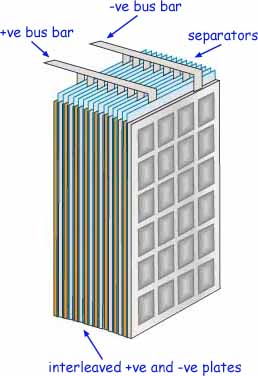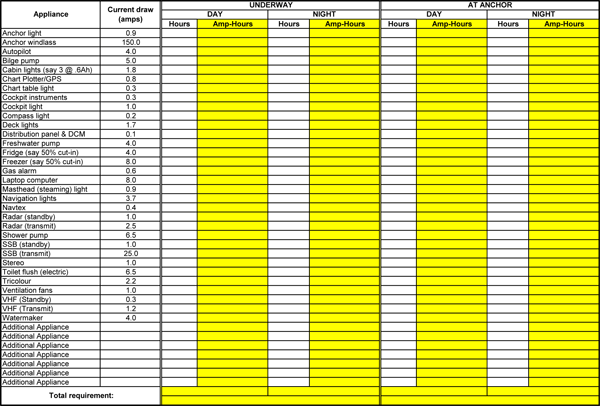- Home
- The 12v Energy Equation
- 12v Demands
Boat Electrics: The Demands of the Domestic System
The subject of boat electrics is a complex one, but the bottom line is that the current draw, battery bank capacity and charging regime must all be matched for the 12volt system to function satisfactorily.
Here we deal with the first part of that equation; calculating the current draw of your of the domestic circuit of the boat electrics over a typical 24 hour period.
Once this is known it's straightforward to assess the required size of the domestic battery bank.
And with that knowledge we can readily calculate the battery charging regime necessary to prevent undue strain on the batteries and keep the whole electrical system ticking over.
Boat Electrics ~ Assessing the Daily Current Draw
To calculate our daily domestic electrical requirement we must first make a list of all electrical equipment on board, and apply a current rating to each item.
If you've got a battery monitor installed in the system and capable of being switched to read amps - like the one shown here - you'll be able, by turning on one item at a time, to read the actual current draw for each item - otherwise you'll have to use a multimeter, or work it out.Ratings can usually be found on equipment nameplates or in their manuals, and will be expressed in terms of power (measured in watts) or current draw (measured in amps). The relationship between power and current is expressed as:
Power (W) = Current (A) x System Voltage (V)
To derive amps from watts, simply transpose this equation and divide the wattage by the system voltage.
For example, a 6 watt navigation light bulb in a 12 volt system will draw 0.5 amps - which, if it's switched for ten hour each day when underway will have consumed 5 amp-hours (Ah).
Continuing in this vein for each item of equipment will produce a table much like that shown below, which incidentally, is the one I did for my boat Alacazam.

This calculation though, remains an estimate. For example:
- in cold weather the fridge will draw less power than in hot weather;
- plus there are start-up currents and other losses that have been ignored.
So it's approximate, but indicates that you'll need to replace around 325Ah each day when you're sailing and 211Ah when you're at anchor.
The underway current consumption clearly presents the worst case scenario, with more power being consumed during the night than during the day. In this example the domestic battery bank will be drawn down by 175Ah during the hour night-time hours - an average discharge of around 14.6A over 12 hours.
So what's the difference between amps (A)
and amp-hours (Ah)?
The best way to explain it is by example...
If an appliance drawing 5A was to run for 1 hour, its consumption would amount to 5Ah.
This would be the same as an appliance drawing 1A running for 5 hours - again the consumption would be 5Ah.
So amp-hours are simply the (average) amperage drawn multiplied by the time in hours.
Boat Electrics ~ Power Conservation
In our example there're several things that could be done to reduce the daily consumption:
- LED (light emitting diode) lights. These draw a fraction of the current taken by a standard incandescent light and have an exceptionally long service life. I reckon if the anchor light, tricolour, cockpit light and cabin lights were replaced with LED's then at least 15amps could be shaved off the underway consumption and a similar amount off when at anchor. A further benefit of a combined anchor/tricolour LED light is that you won't have to scoot up the mast to change a blown bulb - a prospect I view with increasing dismay these days.
- The freshwater pump. Turn it off on passage and use the hand pumps.
Recent Articles
-
About Us
Jan 12, 25 05:05 AM
About Us -
Westerly Nomad Sailboat Specs & Key Performance Indicators
Jan 10, 25 06:54 AM
The Westerly Nomad sailboat specs and KPIs set out here tells us much about how this small cruising boat is likely to behave in a seaway... -
Hunter 376 Sailboat Specs & Key Performance Indicators
Jan 09, 25 02:48 PM
The Hunter 376 sailboat specs and KPIs set out here say a lot about how this B&R-rigged sloop is likely to behave in a seaway...

















